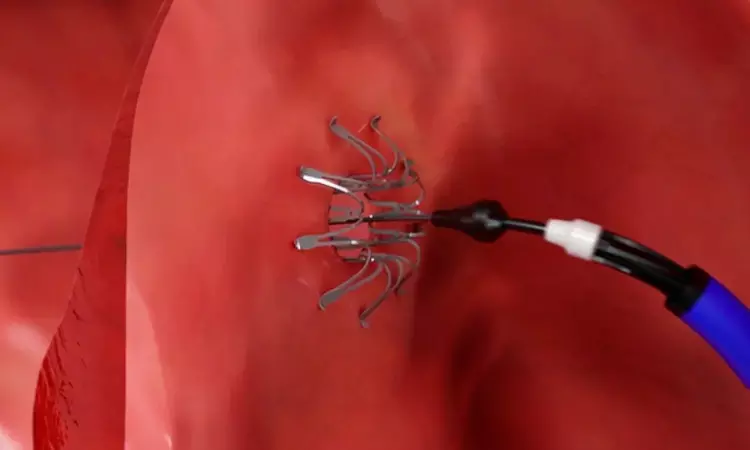- Home
- Medical news & Guidelines
- Anesthesiology
- Cardiology and CTVS
- Critical Care
- Dentistry
- Dermatology
- Diabetes and Endocrinology
- ENT
- Gastroenterology
- Medicine
- Nephrology
- Neurology
- Obstretics-Gynaecology
- Oncology
- Ophthalmology
- Orthopaedics
- Pediatrics-Neonatology
- Psychiatry
- Pulmonology
- Radiology
- Surgery
- Urology
- Laboratory Medicine
- Diet
- Nursing
- Paramedical
- Physiotherapy
- Health news
- Fact Check
- Bone Health Fact Check
- Brain Health Fact Check
- Cancer Related Fact Check
- Child Care Fact Check
- Dental and oral health fact check
- Diabetes and metabolic health fact check
- Diet and Nutrition Fact Check
- Eye and ENT Care Fact Check
- Fitness fact check
- Gut health fact check
- Heart health fact check
- Kidney health fact check
- Medical education fact check
- Men's health fact check
- Respiratory fact check
- Skin and hair care fact check
- Vaccine and Immunization fact check
- Women's health fact check
- AYUSH
- State News
- Andaman and Nicobar Islands
- Andhra Pradesh
- Arunachal Pradesh
- Assam
- Bihar
- Chandigarh
- Chattisgarh
- Dadra and Nagar Haveli
- Daman and Diu
- Delhi
- Goa
- Gujarat
- Haryana
- Himachal Pradesh
- Jammu & Kashmir
- Jharkhand
- Karnataka
- Kerala
- Ladakh
- Lakshadweep
- Madhya Pradesh
- Maharashtra
- Manipur
- Meghalaya
- Mizoram
- Nagaland
- Odisha
- Puducherry
- Punjab
- Rajasthan
- Sikkim
- Tamil Nadu
- Telangana
- Tripura
- Uttar Pradesh
- Uttrakhand
- West Bengal
- Medical Education
- Industry
Atrial shunt device fails to improve health in heart failure with preserved EF: Lancet

USA: A recent study showed that the placement of an atrial shunt device did not improve health status or reduce the total rate of heart failure events in the overall population of patients with heart failure and ejection fraction greater than or equal to 40%.
"The frequency of non-fatal ischemic events, cardiovascular death, and heart failure events were similar in those with and without atrial shunt devices," Prof Sanjiv J Shah, Northwestern University Feinberg School of Medicine, Chicago, IL, USA, and colleagues wrote in their study published in the journal The Lancet.
It was shown in previous studies that Interatrial shunt device placement reduces pulmonary capillary wedge pressure during exercise in patients with heart failure and preserved or mildly reduced ejection fraction. Dr. Shah and the team aimed to investigate whether an interatrial shunt can reduce heart failure events or improve health status in these patients in a randomized, international, blinded, sham-controlled trial performed at 89 healthcare centers.
Patients (aged ≥40 years) with symptomatic heart failure, an ejection fraction of at least 40%, and pulmonary capillary wedge pressure during the exercise of at least 25 mm Hg while exceeding right atrial pressure by at least 5 mm Hg were included. They were randomly assigned in the ratio of 1:1 to receive either a shunt device or sham procedure.
The primary endpoint was a hierarchical composite of cardiovascular death or non-fatal ischemic stroke at 12 months, change in Kansas City Cardiomyopathy Questionnaire overall summary score at 12 months, and rate of total heart failure events up to 24 months. Pre-specified subgroup analyses were performed for the heart failure event endpoint.
Salient findings of the study include:
· 1072 participants were enrolled between May 25, 2017, and July 24, 2020, of whom 626 were randomly assigned to either the atrial shunt device (n=314) or sham procedure (n=312).
· There were no differences between groups in the primary composite endpoint (win ratio 1·0) or in the individual components of the primary endpoint.
· The prespecified subgroups demonstrating a differential effect of atrial shunt device treatment on heart failure events were pulmonary artery systolic pressure at 20W of exercise (>70 mm Hg associated with worse outcomes), right atrial volume index (≥29·7 mL/m2, worse outcomes), and sex (men, worse outcomes).
· There were no differences in the composite safety endpoint between the two groups (n=116 [38%] for shunt device vs n=97 [31%] for sham procedure).
"We found that atrial shunt device placement did not reduce the total rate of heart failure events or improve health status in the overall population of patients with heart failure and ejection fraction of greater than or equal to 40%," the authors concluded.
Reference:
The study titled, "Atrial shunt device for heart failure with preserved and mildly reduced ejection fraction (REDUCE LAP-HF II): a randomised, multicentre, blinded, sham-controlled trial," was published in The Lancet.
KEYWORDS: atrial shunt device, Lancet, ejection fraction, heart failure, cardiovascular death, non-fatal ischemic events, Prof Sanjiv J Shah, heart disease
Dr Kamal Kant Kohli-MBBS, DTCD- a chest specialist with more than 30 years of practice and a flair for writing clinical articles, Dr Kamal Kant Kohli joined Medical Dialogues as a Chief Editor of Medical News. Besides writing articles, as an editor, he proofreads and verifies all the medical content published on Medical Dialogues including those coming from journals, studies,medical conferences,guidelines etc. Email: drkohli@medicaldialogues.in. Contact no. 011-43720751


